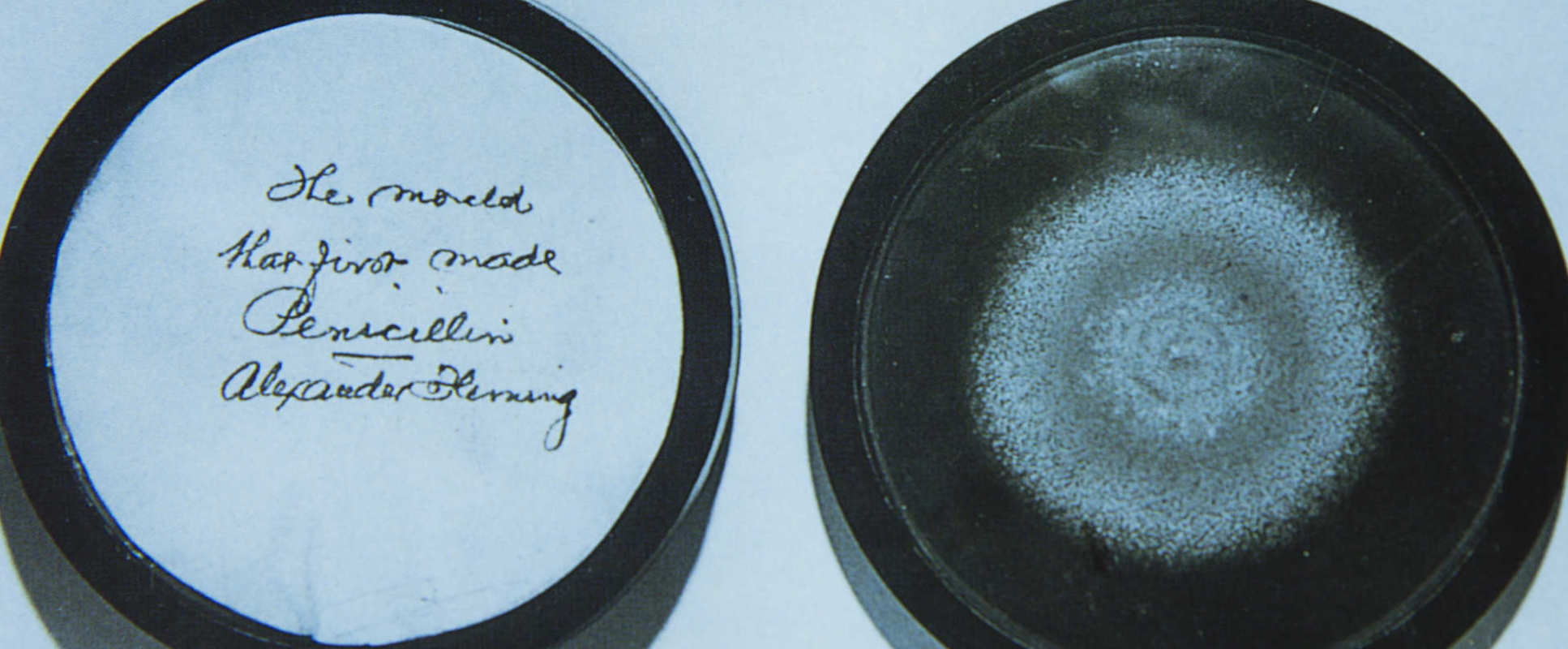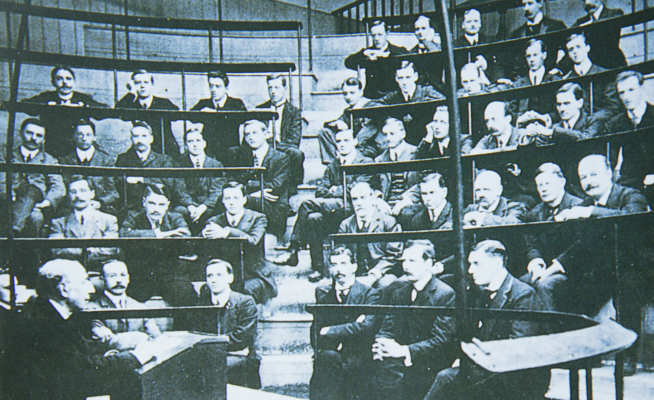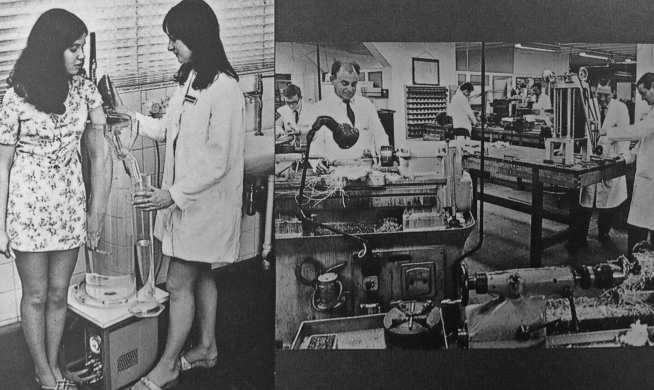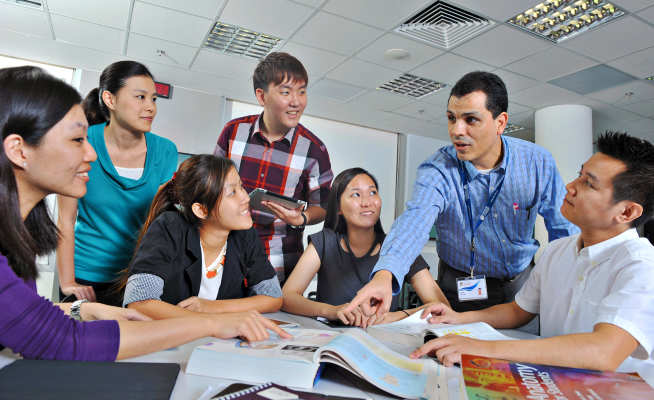
Figure - Alexander Fleming's Penicillin Culture: Sir Alexander Fleming discovered penicillin at St. Mary's in 1928.
The Faculty of Medicine, in its current form, was established in August 1997 through a combination of major west London medical schools. The oldest of these, the Westminster, dates back to the eighteenth century when the system of medical training was not as formalised as it is today.
Some of the key dates in the development of what was to become the Faculty are provided below - these chart some of the milestones in the journey from establishment of our constituent former medical schools through to some of the most recent developments within our Faculty here at Imperial College London - one of the world's leading institutions for medical education and research.
Points of historical significance for our constituent former medical schools, prior to the establishment of Imperial College

- 1823 - Opening of Charing Cross Hospital. The origins of the Charing Cross Hospital Medical School can be found in a meeting of gentlemen at the home of Dr Benjamin Golding to discuss setting up a charitable institution to be known as the West London Infirmary. This was to be a hospital with training facilities, 'to supply the want of a University, so far as medical education is concerned'. Golding drew up a medical education plan in 1822, and the 'West London Infirmary' was established in 1823, to be renamed the Charing Cross Hospital from 1827.
- 1834 - Set-up of what was to become the Westminster Hospital Medical School. The earliest origins of the School date back to the 1700s (when each surgeon was allowed three 'cubs', as the students were known). The School's development continued from 1834 and after a brief hiatus in 1847-8, was re-established in 1849.
- 1854 - St Mary's Hospital Medical School established. St Mary's Hospital was opened in 1851 by Samuel Lane, surgeon and anatomist, and from its inception was intended to be a teaching hospital. The Medical School was founded in 1854, with the number of students soon rising to 40.
From the inception of Imperial College until 1997

- 1893 - Imperial Institute opened by Queen Victoria. The Imperial Institute was created in 1887 to celebrate Queen Victoria's Jubilee with the intention of it being a scientific research institution exploring and developing the raw materials of the Empire countries. It was administered by a Governing body with the then Prince of Wales as President. The Institute was designed by T. E. Collcutt in the neo-renaissance style. It contained a library, laboratories, conference rooms and exhibition galleries with gardens at the rear.
- 1907 - Signing of the Charter forming Imperial College. The final Report of the Board of Education Committee was published in January 1906, recommending combining the Royal College of Science, the Royal School of Mines and the City & Guilds College into one institution.
- 1935 - The British Postgraduate Medical School opens as a school of the University of London at Hammersmith Hospital. This school was a pioneer institution for postgraduate clinical teaching and research, brought into being under the recommendations of the Athlone Report of 1921. From 1947 it was known as the Postgraduate Medical School of London, and in 1974 was renamed the Royal Postgraduate Medical School.
- 1984 - Merger of the Westminster Hospital Medical School with the Charing Cross Hospital Medical School to form the Charing Cross and Westminster Medical School.
- 1988 - Imperial College merges with St Mary's Hospital Medical School. In 1988, Imperial College of Science, Technology & Medicine was formed through the merger of the College with St Mary's Hospital Medical School.
- 1994 - The Medical Research Council establish the MRC Clinical Sciences Centre (CSC) at Hammersmith Hospital to provide a focus of strength in basic science in a clinical environment with the aims of, firstly, undertaking high quality basic science underpinning our understanding of human disease and, secondly, providing the core competencies required to facilitate the translation of this understanding into improved diagnosis and treatment. The MRC CSC became the third directly-funded MRC Institute in 1998 and forms part of the Institute of Clinical Sciences.
- 1995 - Merger with the National Heart & Lung Institute at Royal Brompton. The National Heart and Lung Institute's merger with Imperial in 1995 makes it one of the founding divisions of what later became the School of Medicine. It now carries out pioneering research on all aspects of heart, lung and cardiovascular disease, with increasing emphasis on interdisciplinary work in the areas of biomedicine, biophysics and bioengineering.
From 1997 merger to the present

- 1997 - Imperial College School of Medicine formed. In 1997 the Imperial College School of Medicine was formed, the product of a series of mergers with leading London medical schools. See an archive of the original IC Reporter article from July 1997 discussing this new merger.
- 2001 - Faculty structure introduced. In May 2001, the College organises its departments into a new Faculty structure, and the new Faculty of Medicine is formed.
- 2007 – Imperial College Academic Health Science Centre is created, bringing Imperial College London and the newly launched Imperial College Healthcare NHS Trust into partnership as the UK’s first AHSC.
- 2009 – Official designation of the Imperial College Academic Health Science Centre as an AHSC, as part of the first formal Department of Health designation process.
- 2013 - First students enrol at the Lee Kong Chian School of Medicine in Singapore in August 2013 - a joint initiative between Imperial and Nanyang Technological University (NTU). It is the first degree course from Imperial to have been developed and delivered overseas.
- 2022 - In Summer 2022 the Faculty launched a year of celebrations to mark its 25th Anniversary year - find out more on the anniversary webpages.